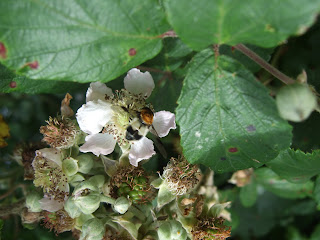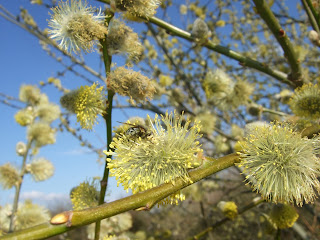I went out after dark tonight and lots of things are starting to move,firstly I met two Dotted border moths on the gable end of house under the yardlight ,these are fairly common moths with a long flight season from Feb -April .
Dotted Border Moth (Agriopis marginaria )
Then I saw a 20 plume moth, This is a small moth that can be found all year round
Twenty Plume Moth (Alucita hexadacytla)
Then I went near open water to check for frogs ,none about yet but some water insects were in evidence.
Water Cricket (Velia caprai) This is a water cricket just the one tonight but I have seen small packs of them hunting along the water surface for smaller prey.They seem to work in groups moving along the waters edge at first while others move along the centre driving the prey into the edge for cover and their comrades in waiting.
Water Boatman (Notanecta sp.)
This is a Water Boatman ,which swims on its back,you can just make out the small hairs at its tail that it uses to propel itself through the water.There are several species and can be identified by looking at their backs for colour patterns.
A Diving Beetle larva. ( Don"t know much about his fellow.)
Caddisfly Larva (Glyphotaelius pellucidus)
This is a Caddis fly larva the white threadlike structures are gills that it uses to breathe.Caddisfly larva can be identified by the kind of cases they build to protect themselves.This one is I believe Glyphotaelius pellucidus which makes a case of fallen leaves.

This was the suprise of the night, this catterpillar was head down about 150mm (6") under water,catterpillars seemingly don"t know how to reverse out of trouble,but some also can live under water like the Brown china mark.I havn"t id ed this yet but will update when I do.
 Hoverflies are some of my favourite insects,their slow drone on a warm day,beautiful colours and aerobatic displays always attract my attention.Their capacity to hover and fly backwards is amazing.They are also good pollinators and devourers of aphids.
Hoverflies are some of my favourite insects,their slow drone on a warm day,beautiful colours and aerobatic displays always attract my attention.Their capacity to hover and fly backwards is amazing.They are also good pollinators and devourers of aphids. (Helophilus pendulus)(Male) also called the Sun fly because it like to bask in sunlight.
(Helophilus pendulus)(Male) also called the Sun fly because it like to bask in sunlight.





































